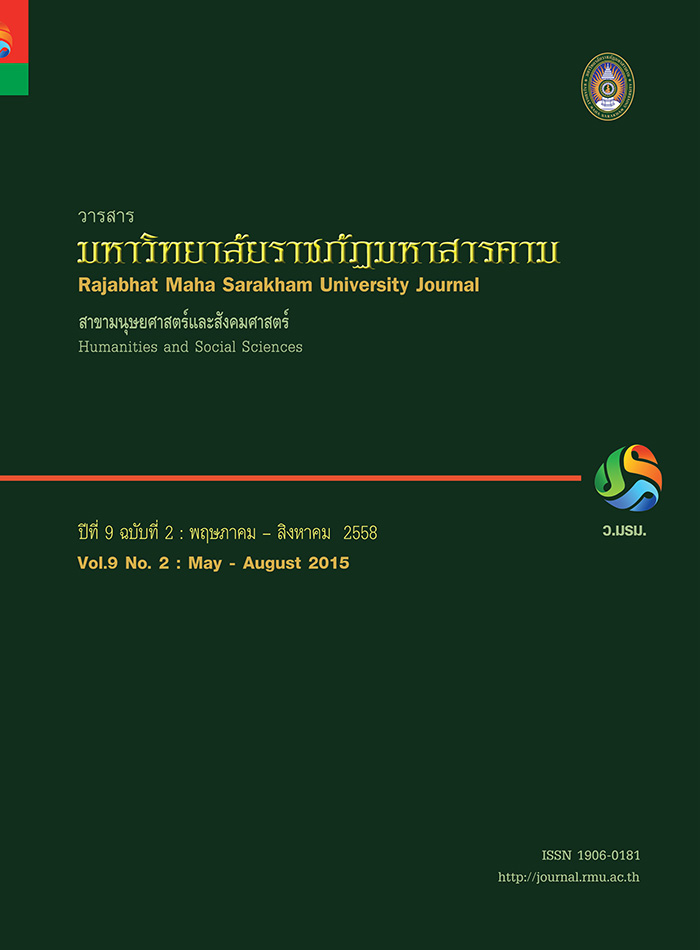รูปแบบการส่งเสริมครูพัฒนาสื่ออิเล็กทรอนิกส์ภายใต้โครงการอีดีแอลทีวี;A Model for Supporting Teachers to Develop Electronic Media in the eDLTV Project
Main Article Content
บทคัดย่อ
การวิจัยมีวัตถุประสงค์ ประการแรก เพื่อศึกษา บริบท ความต้องการ และแนวทางการส่งเสริมครูพัฒนาสื่ออิเล็กทรอนิกส์
ภายใต้โครงการอีดีแอลทีวี เครือข่ายมหาวิทยาลัยราชภัฏมหาสารคาม ประการที่สอง พัฒนารูปแบบการส่งเสริมครูพัฒนาสื่อ
อิเล็กทรอนิกส์ ภายใต้โครงการอีดีแอลทีวี ประการที่สาม พัฒนากิจกรรมการส่งเสริมครูพัฒนาสื่ออิเล็กทรอนิกส์ภายใต้โครงการอีดี
แอลทีวีตามรูปแบบการส่งเสริมครูที่พัฒนาขึ้น และประการที่สี่ เพื่อทดลองใช้รูปแบบการส่งเสริมครูพัฒนาสื่ออิเล็กทรอนิกส์ภายใต้
โครงการอีดีแอลทีวีที่พัฒนาขึ้น วิธีดำเนินการวิจัยตามกระบวนการวิจัยและพัฒนา 4 ระยะ ประชากรและกลุ่มตัวอย่างเป็นครูโรงเรียน
เครือข่ายอีดีแอลทีวี มหาวิทยาลัยราชภัฏมหาสารคาม ระยะที่ 2 จำนวน 469 คน สถิติที่ใช้คือ สถิติพื้นฐาน เครื่องมือการวิจัย คือรูป
แบบการส่งเสริมครูที่ผู้วิจัยพัฒนาขึ้น แบบประเมินรูปแบบ แบบสอบถามและแบบทดสอบผลการเรียนรู้ ผลการวิจัยพบว่า
1. ผลการศึกษา บริบท ความต้องการ และแนวทางการส่งเสริมครูพัฒนาสื่ออิเล็กทรอนิกส์ ภายใต้โครงการอีดีแอลทีวี เครือ
ข่ายมหาวิทยาลัยราชภัฏมหาสารคาม พบว่า มหาวิทยาลัยราชภัฏมหาสารคาม มีหน้าที่ ส่งเสริมการ เผยแพร่ ถ่ายทอด และพัฒนาต่อย
อดสื่ออีดีแอลทีวีภายใต้โครงการอีดีแอลทีวี และจากผลการสำรวจความต้องการ พบว่า 1) โรงเรียนมีความต้องการสื่ออีดีแอลทีวีเพื่อ
การเรียนการสอนร้อยละ 74.65 โรงเรียนมีสื่ออีดีแอลทีวีในการเรียนการสอนร้อยละ 13.09 และโรงเรียนไม่มีความต้องการสื่ออีดีแอล
ทีวีในการเรียนการสอน ร้อยละ 8.91 2) ผู้บริหารและครูสนใจนำสื่ออีดีแอลทีวีไปใช้ในโรงเรียน ร้อยละ 92.44 โดยนำไปใช้เป็นแหล่ง
สืบค้น/แหล่งเรียนรู้ ร้อยละ 88.02 นำไปเป็นสื่อหลักหรือสื่อเสริม ร้อยละ 82.23 นำไปใช้ในกรณีครูได้รับมอบหมายให้สอนไม่ตรงวุฒิ
ร้อยละ 60.17 ครูติดราชการ ร้อยละ 54.60 และครูมีจำนวนไม่ครบชั้น ร้อยละ 25.37 3) การศึกษาแนวทางการส่งเสริมครูในการพัฒนา
สื่ออิเล็กทรอนิกส์ภายใต้โครงการอีดีแอลทีวี พบว่า ครูสนใจเข้าร่วมกิจกรรม ร้อยละ 86.23 โดยสนใจการจัดทำสื่อนำเสนอด้วยโปรแกรม
เพาเวอร์พอยต์ 2007 ร้อยละ 67.97 สนใจการจัดทำสื่อปฏิสัมพันธ์ด้วยเทคโนโลยีมัลติพอยต์ ร้อยละ 67.13 สนใจการจัดทำหนังสือ
อิเล็กทรอนิกส์ ร้อยละ 72.42 สนใจการบูรณาการจัดกิจกรรมการเรียนรู้ด้วยสื่ออิเล็กทรอนิกส์ ร้อยละ 59.33 และ4)ระยะเวลา และ
ความต้องการเข้ารับการอบรม พบว่า ครูมีสนใจเข้ารับการอบรมแต่ละหลักสูตรให้ต่อเนื่องกัน ร้อยละ 95.24 จำนวนวันที่ควรจัดอบรม
ในแต่ละหลักสูตร 2-3 วัน ร้อยละ 96.30 และสนใจในการจัดอบรมในวันหยุด และวันเสาร์-อาทิตย์ 98.94
2. ผลการพัฒนารูปแบบการส่งเสริมครูพัฒนาสื่ออิเล็กทรอนิกส์ภายใต้โครงการอีดีแอลทีวี พบว่า รูปแบบ มีองค์ประกอบ 3
ส่วน คือ สื่อและแหล่งเรียนรู้ กิจกรรมการเรียนรู้ และเป้าหมายของรูปแบบ โดยมีตัวชี้วัด 9 ตัวชี้วัด และความคิดเห็นของผู้เชี่ยวชาญ
มีต่อรูปแบบการส่งเสริมครูอยู่ในระดับมากที่สุด
3. ผลการพัฒนากิจกรรมการส่งเสริมครูตามรูปแบบที่พัฒนาขึ้น พบว่า กิจกรรมการส่งเสริมครู ประกอบด้วย 8 ตัวชี้วัด
The objectives of the research were to study current conditions, needs and strategies for supporting
teachers to develop electronic media in the eDLTV project of Rajabhat Maha Sarakham University, to design
and develop a model for supporting electronic media competency of teachers, to develop training activities
in supporting the electronic media competency of teachers , and to try out the model with target population.
The research methodology was divided into 4 steps: 1) contextual study and need analysis, 2) developing a
model, 3) developing training activities, and 4) trying out of the model. The target population of step 2 was
four hundred and sixty nine teachers from schools under the eDLTV project of Rajabhat Maha Sarakham
University. The statistics used were basic statistics and the research instruments were a model for supporting
electronic media competency of teachers, an assessment form, a questionnaire and an achievement test.
1. The research results showed that the university took an important role in promoting, training and
transferring the electronic media competency to the teachers under the eDLTV project of Rajabhat Maha
Sarakham University. Regarding the contextual study and need analysis., findings revealed the following: 1)
74.65 percent of the teachers needed electronic media for education, 13.09 percent of the schools had
electronic media for education while 8.91 percent of the schools did not need electronic media for education;
2) Regarding school administrators and teachers, findings showed that 92.44 percent of the administrators
and teachers needed to use electronic media as a learning source in the classroom, 88.02 percent of the
administrators and teachers used electronic media as a supplementary material, and 82.23 percent of the
teachers used electronic media as a self-access learning source; 3) 86.23 percent of the teachers were
interested in training the electronic media competency of the eDLTV project, 67.97 percent of the teachers
were interested in presenting media with PowerPoint 2007. 67.13 percent of the teachers were interested in
producing interactive media with the multipoint technology. 72.42 percent of the teachers were interested in
producing e-Book, 59.33 percent of the teachers were interested in integrating electronic media with learning
activities; and 4) Regarding the period and needs to be trained, 95.24 percent of the teachers were interested
to be trained continuously in each course, 96.30 percent preferred 2-3 days in training, and 98.94 percent of
the teachers were interested in being trained on holidays and weekends.
2. The experimental model consisted of three parts: 1) teaching materials and learning sources, 2)
learning activities, and 3) goal of a model, together with night indicators. The study showed that the average
level of the opinion of the experts towards the model was very high.
3. Regarding the training activities for the teachers, the study showed that the activities were divided
into four steps with eight indicators: 1) content analysis and unit design, 2) producing e-book, 3) producing
interactive media, and 4) integrating learning activities with electronic media. The research results showed
that the average level of the opinion of the experts towards the training activities for teachers was very high.
4. The findings indicated that the efficiency value of the model was 85.83/88.33; regarding the
effectiveness of the model, findings revealed that the posttest score of the trainees’ knowledge was significantly
higher than that of the pretest score at the .05 level, and the trainees improved their skills in producing three
types of instructional media at the high level. In addition, the average level of the trainees’ satisfaction with
the model was very high.
Article Details
1. บทความที่ลงตีพิมพ์ทุกเรื่องได้รับการตรวจทางวิชาการโดยผู้ประเมินอิสระ ผู้ทรงคุณวุฒิ (Peer Review) สาขาที่เกี่ยวข้อง อย่างน้อย 3 ท่าน ในรูปแบบ Double blind review
2. ข้อคิดเห็นใด ๆ ของบทความที่ลงตีพิมพ์ในวารสารมหาวิทยาลัยราชภัฏมหาสารคาม นี้เป็นของผู้เขียน คณะผู้จัดทำวารสารไม่จำเป็นต้องเห็นด้วย
3. กองบรรณาธิการวารสารมหาวิทยาลัยราชภัฏมหาสารคาม ไม่สงวนสิทธิ์การคัดลอกแต่ให้อ้างอิงแสดงที่มา


